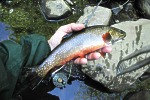LAUREL HILL STATE PARK
This major 70-mile hiking and backpacking trail from Ohiopyle to near Johnstown is the main feature of the park. The trail traverses state parks, state forests, state game lands, other public lands and private lands.
The Laurel Highlands Hiking Trail is open year round and is blazed approximately every 100 feet with 2" and 5" yellow blazes. Side trails are marked with blue blazes. Mileage monuments are every mile.
Large wooden signs mark trail access points at every major highway crossing. Six 30-car parking areas provide starting points. In addition, voluntary day use registration booths are located at each of the parking areas and the trail user is encouraged to fill out information cards for vital park attendance data and for use in the event of an emergency. For overnight use of the trail see Special Regulation 15. Overnight reservations are mandatory. A fee is required for overnight camping.
There are eight overnight shelter areas along the trail. Each area contains 5 adirondack-type shelters with fireplaces, 2 non-flush toilets, a water supply and spaces for 30 tents.
The Laurel Hill Valley escaped the unbridled logging that swept through Pennsylvania?for longer than many areas of the state. The steep stream valleys and rugged hills made logging difficult until technology laid the tracks to enable the trees to be hauled to mills. Powerful, slow locomotives climbed the switchbacked tracks through Laurel Hill and hauled the logs to mills. From 1886 to 1940, logging companies clearcut the trees of the park, leaving behind a wasteland of brambles prone to forest fires and flooding. Only the area now called Hemlock Natural Area escaped the loggers? reach.
Beginning in 1935, the Federal Emergency Relief Administration began purchasing submarginal agricultural and forest land so that it could be converted to better use. In 1936, the National Park Service was given the responsibility of the Recreational Demonstration Areas. Laurel Hill was one of five areas in Pennsylvania and targeted for restoration and reforestation, and organized group camping and day picnicking.
Beginning in 1935, with cooperation of the Pennsylvania Department of Forests and Waters, men of the Works Progress Administration (WPA) and the Civilian Conservation Corps (CCC) began building roads, trails, bridges and recreational facilities.
Two CCC camps, SP-8 and SP-15 arrived in July 1, 1935 and began building camps for themselves (currently Group Camp 8 and Group Camp 5). The 200 young men in each camp worked year-round building park facilities like group camps, picnic areas, waterlines, roads, the beach house and Laurel Hill Lake. World War II ended the CCC.
In October of 1945, the Department of the Interior transferred the project to the Commonwealth of Pennsylvania and it became Laurel Hill State Park.
The Laurel Hill Recreational Demonstration Area Historic District includes all CCC-constructed buildings and structures that retain a significant degree of integrity. The district contains 202 buildings on 1,352 acres of land, which is the largest collection of CCC architecture in Pennsylvania State Parks.
Organized Group Camps: Large cabin camps are available for nonprofit organized youth and adult groups from mid-April to mid-October. Facilities include flush toilets, central shower house, large dining hall and kitchen, plus, small cabins for campers. Applications are only available at the park office.
Camping Cottages: Eight cottages near the campground sleep five people in single bunks and double/single bunks, and have wooden floors, windows, porch, picnic table, fire ring and electric lights and outlets.
Camping: modern sites, some with electricity
The camping area consists of 264 tent or trailer sites (149 with electric) with flush toilets, hot water showers, sanitary dumping stations and drinking water.
One walled tent is available for rent. The tent sleeps six people and has a refrigerator, bunk beds with mattresses and electricity. Campers must bring bedding, camping stove, and cooking and eating utensils.
The campground is open from the second Friday in April until mid-October. Site occupancy is limited to one family unit (persons living under one household) or one non-family unit limited to five persons, including one responsible individual 18 years of age or older. The maximum camping period is 14 consecutive nights.
Organized Group Tenting:
Qualified, organized adult and youth groups may use the 125-person capacity area. This area is open year-round and has limited facilities with vault toilets, drinking water, fire rings and picnic tables. Area regulations require that 1) A roster be submitted, 2) Fires are built only in designated locations, 3) Standing timber must not be cut, and 4) Trailers are not permitted in this area.
Tucked away in a secluded area of Laurel Hill State Park, Laurel Hill Lodge is modern yet has much rustic charm. The large fireplace, cathedral ceiling, and large, private deck overlooking the park and the Laurel Mountains make the lodge cozy and spectacular.
The lodge is especially equipped for the winter recreation season, including ski and snowboard racks, and glove and boot dyers. The two-story lodge has five bedrooms, which sleep 14 guests in five double beds (including two futons) and six twin beds (bunk beds). The lodge has three bathrooms (two full, one ?), one and one-half kitchens, recreation room and laundry. The hot water heating system will keep you warm and cozy.



